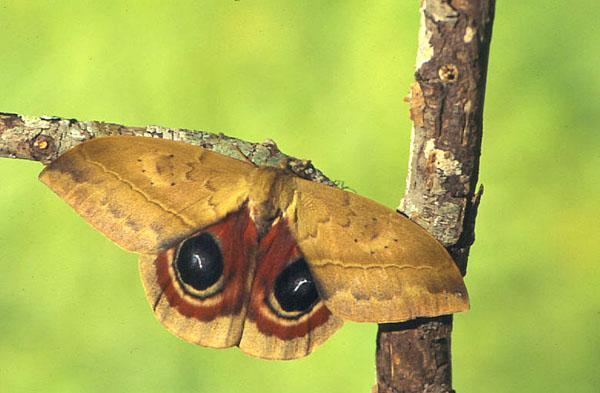Automeris janus
awe-too-MER-ihsMJAY-nuhs
Cramer, 1775
(Phalaena Attacus)

Photo courtesy of Leroy Simon
TAXONOMY:Superfamily: Bombycoidea, Latreille, 1802 |
"Someone to Watch Over Me" |
|
|
Updated from Polillas Saturnidas de Colombia, 1997, Angela R. Amarillo-S., January 2007 Updated as per Lemaire's Hemileucinae 2002, February 5, 2007 Updated as per personal communication with Johnny Marchant (Belizon), March 2007 Updated as per L. Racheli & T. Racheli, SHILAP, Vol. 33, # 130, 2005, March 2007 Updated as per http://www.inbio.ac.cr/bims/k02/p05/c029/o0119/f00885.htm IB, April 2008 Updated as per personal communication with Vladimir Izersky (Rio Venado, Junin, Peru, January 26, 2008, 1050m), December 2008 Updated as per personal communication with Peter Bruce-Jones (Shima, Junin, Peru, June, 700m); January 21, 2011 Updated as per personal communication with Gregory Nielsen (Villavicencio, Meta, Colombia, April 1, 2011, 500m); April 7, 2011 Updated as per personal communication with John S. Christensen (Rio Shima, Junin, Peru, mid May 2014, 450m); March 11, 2015 |

TAXONOMY:Superfamily: Bombycoidea, Latreille, 1802 |
"Someone to Watch Over Me" |
It has also been reported in
Costa Rica:
Alajuela, Cartago, Guanacaste, Heredia, Limon, Puntarenas and San Jose; and
probably in Panama.
It is usually found at elevations from 150-1450m.
Visit Automeris janus male, Rio Venado, Junin, Peru, January 26, 2008, 1050m, courtesy of Vladimir Izersky.
Visit Automeris janus males and female, Shima, Junin, Peru, June 12-14, 2010, 700m, courtesy of Peter Bruce-Jones.
Visit Automeris janus male, Villavicencio, Meta, Colombia, April 1, 20101, 500m, courtesy of Gregory Nielsen.
Visit Automeris janus males and females, Rio Shima, Junin, Peru, mid may, 2014, 450m, courtesy of John Christensen.

Automeris janus male, 14 km out on road to Belizon,
French Guiana,
February 20-March 7, courtesy of Johnny Marchant.
Metzli is clearly lighter than the other two and has an elongated forewing with a straight postmedial line. Exigua has a straight postmedial line in contrast to the undulating line of janus.

Automeris janus male, Ecuador, courtesy of Leroy Simon.
Larvae feed on Kaffir tree/Coral tree, Beech and Apple. It has also been reared on Salix petandra.

Automeris janus, female, courtesy of Robert Thompson.

Automeris janus, female, courtesy of Robert Thompson.

Automeris janus female, French Guiana, courtesy of Carlot Didier.

Automeris janus male, French Guiana, courtesy of Carlot Didier.
Urticating spines offer the Automeris larvae much protection.
Pupa is smooth and dark brown in a finely meshed cocoon, spun up amongst leaves.

Automeris janus final instar, Ecuador, courtesy of Leroy Simon.

Automeris janus 7th instar courtesy of Bernhard Wenczel.
Cocos nucifera |
Coconut palm/Coco palm |
The pronunciation of scientific names is
troublesome for many. The "suggestion" at the top of the page is
merely a suggestion. It is based on commonly
accepted English pronunciation of Greek names and/or some
fairly well accepted "rules" for latinized scientific names.
The suggested pronunciations, on this page and on other pages,
are primarily put forward to assist those who hear with internal
ears as they read.
There are many collectors from different countries whose
intonations and accents would be different.